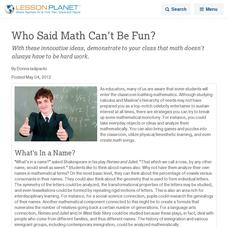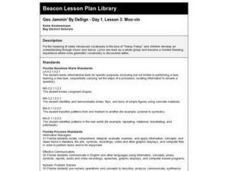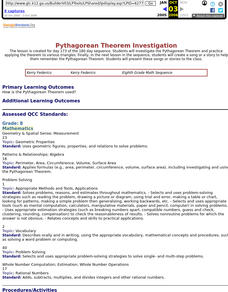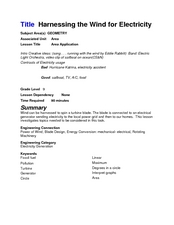Curated OER
Who Said Math Can't Be Fun?
With these innovative ideas, demonstrate to your class that math doesn't always have to be hard work.
Scholastic
Study Jams! Types of Lines
Get jamming with lines and sing along to this karaoke that reviews the main types of lines. Your learners can't forget the main properties of lines when they sing the chorus on the karaoke song after the included slide show. The slides...
Scholastic
Study Jams! Classify Quadrilaterals
Face the vertex of two-dimensional shapes and discover what each figure requires as part of its classification. With one shape per slide, learners see what makes each shape special and compare it to others with similar qualities.
Curated OER
Geometry, Pi, and Ancient Civilizations
By working together, pairs of students will complete a Pi webquest. Using the internet, they examine the ways people in the Ancient Civilizations of Egypt, Babylonia and Greece used Pi. To end the lesson plan, they review the concepts of...
Curated OER
Geometry Gymnastics
Students identify shapes and manipulate 2 and 3 dimensional objects. They view objects from different perspectives and review relative positions (near, far, between). They sing a shape song.
Curated OER
Volume of Rectangular Prisms: Algebra/Geometry Institute Summer 2009
Students find the volume of rectangular prisms. In this volume lesson, students use a formula to find the volume of rectangular prisms. They discuss the definition of volume and draw rectangular prisms. Students...
Scholastic
Study Jams! Measure Angles
Get a quick review on measuring angles with this step-by-step guide using a protractor. Watch the correct way to measure angles and finish with an assessment on correct techniques to measure special angles.
Curated OER
Shaping Up!
Kindergartners are introduced to basic shapes. Learners spend 45 minutes a day in geometry centers carrying out the activities outlined in this ambitious plan. There are games, hands-on activities, interactive websites, art projects,...
Curated OER
Basic Geometry Ideas and Angle Measurement
Seventh graders explore the concept of basic geometry. In this basic geometry instructional activity, 7th graders identify the correct picture for a given vocabulary word such as midpoint, line, ray, or parallel lines. Students discuss...
Curated OER
Volume and Surface Area of Right Rectangular Prisms
Students identify the formulas for three-dimensional figures. They use manipulatives to model problems. Students create foldables and explain volume and surface area. Students complete worksheets and classify solids. Students sing a...
Curated OER
Tessellations WOW!
Students identify and manipulate shapes to create tessellations. In these geometry/spatial relations lessons, the students use of a variety of modalities such as literature, music, writing, and art as introductions to the concept of...
Curated OER
Angles, Triangles, Quadrilaterals, Circles and Related
Students classify angles. For this angles lesson, students explore the characteristics of angles, triangles, quadrilaterals and circles. They identify polygons and sing a classifying angles song. Students participate in a manipulative...
Curated OER
Plane Figures
Fifth graders create polygons requested by their teacher. In this polygons lesson, 5th graders watch a video and listen to a song about polygons. Then, students take turns labeling various polygons and practice making polygons.
Alabama Learning Exchange
It's Around There Somewhere! Perimeter, and Circumference
Explore the concept of building equations for perimeter and circumference. Learners use rulers to measure the perimeter of half a sheet of paper. Then fold the sheet of paper numerous times, each time measuring perimeter. ...
Curated OER
Time Foldable
First graders listen to and discuss the book, The Time Song. In this math instructional activity, 1st graders discover what they can do in a second, a minute, and a hour. Additionally students create a flap book to display time...
Curated OER
Kindergarten Geometry
Students choose a square of any size and use yarn to show that all 4 sides are the same. They sort the traffic sign cards into groups of squares and non-squares. Also they make a square using Q-tips; tell how you know it is a square.
Curated OER
1, 2, 3 o' Clock Rock
Second graders identify the hour and minute hands. They tell time by the hour, nearest quarter hour, half hour, and determine the relationships of time (e.g. minutes in hour, days in a month, weeks in a year). They create over-sized...
Curated OER
Day #8 - Fractals
Students explore fractals and draw fractal curves. To assist in remembering the methods, they sing a song about fractals, watch a video, and create images of fractals on dot paper. Students observe and discuss a comic strip about...
Curated OER
Statistics and Probility
Seventh graders collect data and make predictions. In this geometry lesson, 7th graders work in tiers collecting data and plotting it. They make inferences and predictions about their collected data.
Curated OER
Geo Jammin' - Day 6, Lesson 20: Hail, Hail, the Gang's All Here
Students use shape puppets to review geometry content. They take turns singing songs, reading students poems, reciting class bulletin board notes and choral poems. They prepare for their summative assessments through play and interview...
Curated OER
Geo Jammin' By DeSign - Day 1, Lesson 3: Moo-vin
Second graders practice new geometry vocabulary by putting the words to the tune of "Hokey Pokey." students use the lyrics as a guided reading experience.
Curated OER
Pythagorean Theorem Investigation
Eighth graders investigate the Pythagorean Theorem and practice applying the theorem to various triangles. Finally, in the next lesson in the sequence, 8th graders create a song or a story to help them remember the Pythagorean Theorem.
Curated OER
Introduction to Biometrics
Students use the internet to research how biometrics is being used in the real world today. They work together to research hand geometry applications. They share their findings with the class.
Curated OER
Harnessing the Wind for Electricity
Ninth graders explain how wind can produce electricity. In this geometry instructional activity, 9th graders construct their own pin wheel turbine and calculate its power. They discuss the pros and cons of using wind generator.






















